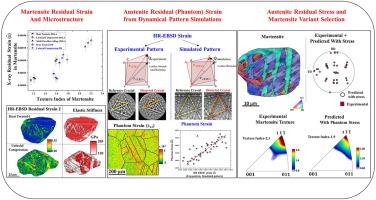Austenite residual stress and lath martensite variant selection in low carbon steels
IF 8.3
1区 材料科学
Q1 MATERIALS SCIENCE, MULTIDISCIPLINARY
引用次数: 0
Abstract
Controlled thermomechanical processing, in the austenite phase of two different steel grades, produced 15 different martensitic microstructures. The variant selection and the hierarchy of martensite were affected. Both, hierarchy and variant selection of the predominantly lath martensite, scaled with experimental bulk martensite residual strains (). Local and martensite crystallography, on the other hand, appeared to provide an elastic strain energy minimization. A novel methodology of estimating residual strain in the ‘invisible’ austenite phase was then proposed and validated. This approach combined pixel-by-pixel prior austenite reconstruction with dynamical high-resolution Kikuchi pattern simulations. Pattern simulation-based Phantom strain(s), considering only pattern rotation, scaled linearly with experimental, micro-Laue diffraction and microtexture based, lattice strain(s). This study was then extended to a residual stress assisted, and interaction energy based, martensite variant selection model. It was clearly shown that the austenite residual stress, estimated from pattern simulations of reconstructed austenite, controlled the martensite variant selection.


求助全文
约1分钟内获得全文
求助全文
来源期刊

Acta Materialia
工程技术-材料科学:综合
CiteScore
16.10
自引率
8.50%
发文量
801
审稿时长
53 days
期刊介绍:
Acta Materialia serves as a platform for publishing full-length, original papers and commissioned overviews that contribute to a profound understanding of the correlation between the processing, structure, and properties of inorganic materials. The journal seeks papers with high impact potential or those that significantly propel the field forward. The scope includes the atomic and molecular arrangements, chemical and electronic structures, and microstructure of materials, focusing on their mechanical or functional behavior across all length scales, including nanostructures.
 求助内容:
求助内容: 应助结果提醒方式:
应助结果提醒方式:


